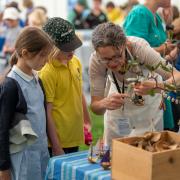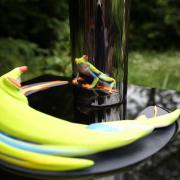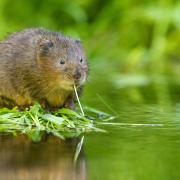It was a bitter-sweet moment. At the bottom of a bank in my garden, a tiny ball of golden fur was curled at my feet. For years we’d wondered if dormice were resident on our patch and this little fellow gave us the answer – but in mid-winter I would much rather not have discovered this semi-comatose bundle of loveliness who should have been deeply hibernating in a cosy nest. All was not well; I clearly needed an expert.
Our native hazel dormouse was once widespread in Britain, but over the last century numbers and range have reduced dramatically – and between 2000 and 2019 an already depleted population declined by a further 51 per cent. They are now described as a ‘Species of Conservation Concern’ and are extinct in at least 17 British counties. Dreadful.
Causes are manifold. The UK-wide loss of hedgerow networks and fragmentation of woodlands, as well as changes in woodland management and farming practices, along with the overarching problem of climate change, all contribute to threaten the beleaguered dormouse. Often regarded as an ‘indicator’ species, habitats that support a healthy population of hazel dormice are also ideal for many other species, such as songbirds, bats and various insects, so a strong dormouse population indicates a healthy biodiversity.

The depletion of this endearing one-ounce wonder, with its huge eyes, long whiskers and furry tail, is just one of many wake-up calls to humanity to take remedial environmental action and improve practices.
Thankfully, there is hope for our dormice.
People’s Trust for Endangered Species (PTES) manages the National Dormouse Monitoring Programme (NDMP), which was set up in 1990 to monitor Britain’s hazel dormouse population. This scheme provides information on where dormice are still to be found and which conservation efforts are successful. It is a vital tool for ongoing dormouse protection.

Ian White, dormouse and training officer at the trust, says: ‘The data from the programme is analysed annually and we hope to publish a State of Britain’s Dormice 2023 report towards the end of this year, which will outline how dormice are faring across the country. The trust’s ‘State of’ reports are the most up-to-date and comprehensive overview of how the nation’s dormouse population is faring.’
Southern England is one of the remaining strongholds for the hazel dormouse and many places in Devon support a reasonable population, although they are still not widespread. Down here, charities such as Devon Wildlife Trust and the National Trust, along with wilding projects such as that at Cove Down above the Exe Valley, actively take steps to provide habitat that will support dormice. They also have people licensed to handle and monitor them as part of the NDMP.
Dormice love the new growth of woody vegetation that arises from traditional woodland management such as coppicing – a practice that is being reintroduced at many conservation sites.

A new PTES initiative, launched in April, is the hazel dormouse ‘footprint tunnel’ survey. The tunnels, comprising a square tube with plywood insert, are attached beneath a branch. Paper and an ink pad are placed onto the plywood, so that when the arboreal dormouse walks over the pad, he or she leaves footprints on the paper.
‘Footprint tunnels are an excellent way to survey for dormice in most habitats, although they work best in hedges or scrub,’ Ian says. ‘It only shows presence or likely absence; it does not give an indication of dormouse density. Unlike a nest tube or box where a dormouse needs to be present or to have built a nest to be recorded, at a footprint tunnel it only takes a fleeting visit for a dormouse to be detected. This means that there is a higher detection rate when compared with conventional nest tubes and boxes.’
In counties where dormice are extinct a reintroduction programme has been in operation since 1993. The first of these took place in Cambridgeshire – and 30 years later dormice are still present at that site.

Ian says: ‘But, such reintroductions work only as long as all the elements needed to make them a success are in place, and will be continued for the foreseeable future, such as correct woodland management practices and a strong team of dedicated volunteers on hand to help.
‘Volunteers will often undertake any woodland management needed and also check the dormouse nest boxes across the woodland to monitor the population. It’s always very rewarding when they see the benefits of their hard work managing the woodland during winter, by finding dormice in the nest boxes during spring, summer and early autumn.’
In Devon, because local populations are reasonably sound, it hasn’t needed to undertake reintroductions, but monitoring work does take place to keep an eye on our dormouse levels. One Devon stronghold is at Lady’s Wood, Devon Wildlife Trust’s first nature reserve, situated on the edge of Dartmoor.

Nest box schemes, similar to those established for birds, are used to encourage dormice at suitable sites. A dormouse box has an inward-facing hole, positioned protectively towards the trunk of a tree.
Ian tells me an appealing human-dormouse story: “Ten years ago, PTES started working with HMP Humber who produce dormouse nest boxes, which are then delivered to woodland sites that are part of the monitoring programme. We provide the timber and materials needed to make the boxes and HMP Humber provides the labour. It’s a great project between a conservation charity and the prison, but it also provides a practical task for HMP Humber’s men, whilst supporting one of our most enigmatic native animals. To date over 20,000 boxes have been made and distributed throughout the country.’
Pleasingly, in 2021 the trust and its partner organisations celebrated a milestone when the 1,000th dormouse was reintroduced to a woodland in Lancashire.

We may have dormice in Devon but their population here is far from what it was at their peak, so there’s no room for complacency.
‘Anything people can do to improve woodland management will help dormice – as well as lots of other species,’ Ian says. ‘If people want to do something practical they can consider joining their local wildlife trust or the National Trust, and volunteer for any practical tasks. They can also help by improving local hedges – learning how to hedge lay, or taking part in PTES’ Great British Hedgerow Survey. This tells us how local hedgerows are doing and if they are suitable for dormice.
‘We also run woodland management training sessions for landowners and land managers,’ he says. ‘These help to ensure that people manage their woodlands in the best way possible for dormice and other species. If the correct habitat offering the right food is present, dormice can survive.’

It seems a classic case of thinking globally, acting locally. The wider picture of climate crisis is bleak, but if we all do something to improve our local patch, then all those small somethings join up into something much bigger – better for dormice, better for everyone.
Sadly, ‘my’ little golden dormouse didn’t survive, but Ian says: ‘The trust will continue to restore dormouse populations in whatever ways we can to ensure this charismatic species doesn’t get lost from our countryside.’



























